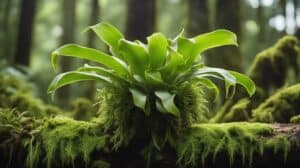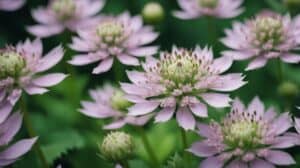Pitcher plants are a fascinating group of carnivorous plants that have captured the imagination of botanists and plant enthusiasts alike.
Two of the most intriguing genera of pitcher plants are Nepenthes and Sarracenia.
These plants have evolved unique adaptations that allow them to capture and digest insects and other small prey.

Nepenthes, also known as tropical pitcher plants, are native to Southeast Asia, Madagascar, and Australia.
They are known for their strikingly beautiful and intricate pitchers, which come in a wide range of colors and shapes.
Some species of Nepenthes are even capable of capturing and digesting small mammals, such as mice and shrews.
Sarracenia, on the other hand, are native to North America and are commonly known as the trumpet pitcher plants.
They are characterized by their tall, slender pitchers that are often adorned with intricate patterns and colors.
Sarracenia are highly adapted to nutrient-poor environments, and their pitchers are designed to capture and digest insects and other small prey to supplement their diet.
The Allure of Carnivorous Plants

Carnivorous plants have always been a source of fascination for people.
They are a unique group of plants that have evolved to attract, capture, and digest insects and other small prey.
The most well-known carnivorous plants are the Venus flytrap, pitcher plants, and sundews.
Pitcher plants are particularly intriguing because of their unique shape and the way they capture their prey.
Nepenthes, also known as tropical pitcher plants, have a unique pitcher-shaped structure that is filled with a digestive fluid.
Sarracenia, also known as North American pitcher plants, have a similar structure but with a different mechanism for capturing prey.
The allure of carnivorous plants lies in their ability to adapt to their environment and survive in nutrient-poor soils.
By capturing insects and other small prey, they are able to obtain the nutrients they need to grow and thrive.
This unique adaptation has allowed them to survive in environments where other plants cannot.
Carnivorous plants also have a certain mystique about them.
They are often associated with exotic locations and have been the subject of many myths and legends.
Their unique appearance and behavior have captured the imagination of people for centuries.
In addition to their intrigue, carnivorous plants also have practical applications.
They have been used in traditional medicine to treat a variety of ailments, and their unique adaptations have inspired scientists to study them for potential use in agriculture and environmental remediation.
Overall, the allure of carnivorous plants is undeniable.
Their unique adaptations, intriguing appearance, and practical applications make them a fascinating subject for study and appreciation.
Diving into Nepenthes
Nepenthes, commonly known as tropical pitcher plants, are a diverse and intriguing group of carnivorous plants.
This section will explore the species diversity, habitat and distribution, and unique adaptations of Nepenthes.
Species Diversity
There are over 170 species of Nepenthes, ranging in size from tiny plants with pitchers only a few centimeters long to impressive giants with pitchers over 30 centimeters in length.
The pitchers themselves come in a variety of shapes and colors, from slender and cylindrical to broad and bulbous, and from green to red to black.
Habitat and Distribution
Nepenthes are native to tropical regions of Southeast Asia, including Borneo, Sumatra, and the Philippines.
They are found in a variety of habitats, including lowland rainforests, montane forests, and even on limestone cliffs.
Many species are endemic to small islands, making them vulnerable to habitat loss and extinction.
Unique Adaptations
One of the most fascinating aspects of Nepenthes is their unique adaptations for capturing prey.
The pitchers are filled with a slippery liquid that lures insects inside, where they become trapped and eventually digested by enzymes.
Some species even have specialized structures, such as slippery walls or sticky hairs, to prevent insects from escaping.
In addition to their carnivorous habits, Nepenthes have also developed adaptations for surviving in nutrient-poor soils.
Many species have evolved symbiotic relationships with ants, which help to protect the plants from herbivores and provide them with additional nutrients.
Overall, Nepenthes are a fascinating group of plants with a wide range of adaptations and ecological roles.
Exploring Sarracenia

North American Natives
Sarracenia is a genus of carnivorous plants native to North America, commonly known as pitcher plants due to their distinctive shape.
They are found in wetlands and bogs throughout the southeastern United States, with the highest concentration in the Gulf Coast region.
There are eight recognized species of Sarracenia, each with its own unique characteristics and requirements.
Conservation Status
Unfortunately, many Sarracenia species are threatened or endangered due to habitat loss and poaching.
The International Union for Conservation of Nature (IUCN) has listed several species as vulnerable or endangered, including Sarracenia alata and Sarracenia rubra.
It is important to only purchase Sarracenia from reputable nurseries and to never take plants from the wild.
Cultivation and Care
Sarracenia are relatively easy to grow and care for, making them a popular choice for carnivorous plant enthusiasts.
They require a lot of sunlight and should be planted in a well-draining soil mix that is kept moist at all times.
Sarracenia are also heavy feeders and should be fertilized regularly with a low-nitrogen fertilizer.
It is important to use distilled or rainwater when watering Sarracenia, as tap water can contain minerals that are harmful to the plant.
Overall, Sarracenia are fascinating plants that are both beautiful and functional.
With proper care and attention, they can thrive in a variety of growing conditions and provide a unique addition to any carnivorous plant collection.
Pitcher Plant Interactions with the Ecosystem

Pitcher plants are fascinating not only for their unique appearance but also for their interactions with their surroundings.
These carnivorous plants have evolved to survive in nutrient-poor environments and have developed various mechanisms to attract, capture, and digest prey.
One of the most interesting aspects of pitcher plants is their symbiotic relationship with insects.
The slippery walls of the pitcher plant’s tubular leaves are coated with a waxy substance that makes it difficult for insects to climb out once they have fallen in.
The insects become trapped in the plant’s digestive juices and are slowly broken down into nutrients that the plant can absorb.
Pitcher plants also play an important role in their ecosystems by providing habitats for a variety of organisms.
The water-filled pitchers of some species, such as Sarracenia purpurea, serve as breeding sites for aquatic insects like mosquitoes and midges.
These insects in turn provide food for other animals, such as fish and birds.
In addition, pitcher plants have been found to have antimicrobial properties.
The nectar secreted by the plant’s glands contains chemicals that inhibit the growth of bacteria and fungi, which may help to prevent disease in the plant and its surroundings.
Overall, pitcher plants are fascinating examples of how plants have adapted to survive in challenging environments.
Their unique interactions with their ecosystems make them important components of many wetland habitats.
Frequently Asked Questions

How do Sarracenia pitcher plants capture and digest their prey?
Sarracenia pitcher plants have a unique method of capturing and digesting their prey.
The pitchers of these plants are modified leaves that are shaped like a tube or a trumpet.
The inside of the pitcher is lined with downward-facing hairs that make it difficult for insects to climb out.
The top of the pitcher is open, and insects are attracted to the plant by nectar secreted by the plant.
Once inside, the insects are unable to climb back out due to the slippery walls and downward-facing hairs.
The insects eventually fall into the digestive fluid at the bottom of the pitcher, which breaks down the prey into nutrients that the plant can absorb.
What are the distinguishing traits of Nepenthes species compared to other carnivorous plants?
Nepenthes, also known as tropical pitcher plants, have some unique traits that set them apart from other carnivorous plants.
One of the most distinctive features of Nepenthes is their pitcher-shaped traps, which are often brightly colored and can grow up to 1 foot in length.
Nepenthes also have a unique way of capturing prey, using a slippery rim and a waxy surface to lure insects into the trap.
Additionally, Nepenthes have a symbiotic relationship with ants, which live in the pitchers and help to protect the plant from other insects.
In what environments can you typically find pitcher plants thriving?
Pitcher plants can be found in a variety of environments, but they typically thrive in wetlands, bogs, and other areas with nutrient-poor soil.
Sarracenia pitcher plants are native to North America and can be found in wetlands and swamps throughout the southeastern United States.
Nepenthes are native to tropical regions of Southeast Asia, where they grow in rainforests and other humid environments.
What adaptations allow pitcher plants to survive in nutrient-poor soils?
Pitcher plants have evolved a number of adaptations that allow them to survive in nutrient-poor soils.
One of the most important adaptations is their ability to capture and digest insects, which provides them with the nutrients they need to survive.
Additionally, pitcher plants have developed specialized leaves that are modified into traps, which help them to capture prey.
Some pitcher plants also have a symbiotic relationship with bacteria and other microorganisms, which help to break down the prey into nutrients that the plant can absorb.
How can you care for a pitcher plant in a home environment?
Pitcher plants can be grown indoors in a bright, sunny location with high humidity.
They require moist soil and should be watered regularly to keep the soil moist but not waterlogged.
Pitcher plants also benefit from being fertilized occasionally with a diluted solution of insectivorous plant fertilizer.
It’s important to avoid using tap water, as the minerals in the water can harm the plant. Instead, distilled or rainwater should be used.
What role do pitcher plants play in their ecosystems?
Pitcher plants play an important role in their ecosystems by providing a habitat and a food source for a variety of insects and other small organisms.
They are also an important part of the food chain, providing nutrients for other animals that feed on the insects trapped in their pitchers.
Additionally, pitcher plants help to control insect populations and can be used as a natural pest control method in gardens and other outdoor spaces.














